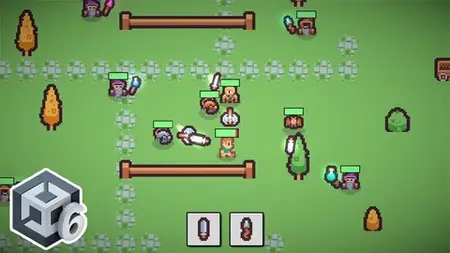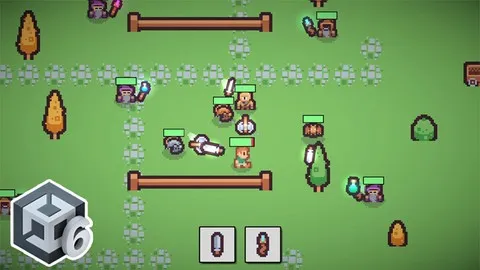Learn To Create A 2D Rpg In Unity 6
Published 2/2025
MP4 | Video: h264, 1920x1080 | Audio: AAC, 44.1 KHz
Language: English | Size: 10.36 GB | Duration: 21h 26m
Published 2/2025
MP4 | Video: h264, 1920x1080 | Audio: AAC, 44.1 KHz
Language: English | Size: 10.36 GB | Duration: 21h 26m
Create your own RPG game with a complete combat system and different enemies in Unity 6 using C#
What you'll learn
Learn C# from Scratch, An Efficient Language Used in Unity
Gain Experience in Unity 6 – The Latest Version Released in Late 2024
Design, Develop, and Deploy a Complete RPG Project
Implement Various Weapons and Enemies Using Prefabs and Advanced Concepts
Understand Not Only the Fundamentals but Also More Complex Topics
Enhance Game Feel with Visual and Particle Effects
Learn to Refactor Your Code for Improved Quality
Gain Hands-On Experience in EVERY SINGLE LESSON
Write Clean and Expandable C# Code
Boost Development Productivity with Keyboard Shortcuts and Expert Tips
Requirements
No experience needed
Description
Step into the world of game development with a hands-on, project-based course where you'll create your very own 2D RPG game using Unity! In this course, you'll build a fully functional game from scratch that features:Complete combat systemDifferent enemiesSmooth player movementDual combat mechanics with a close-range knife and long-range potion attacksDynamic health systemAnd much more!You'll also learn how to bring your game to life with polished visual effects such as potion trails, dynamic lighting, and particle effects that add that special "game juice" everyone loves. Whether you're a beginner eager to dive in or an intermediate developer looking to enhance your skills, this course provides a clear, step-by-step path to building a complete game project.What You'll LearnUnity Fundamentals & Project Setup: Master the Unity interface, scene setup, asset organization, and the basics of 2D game development.Player & Combat Mechanics: Code fluid player movement and implement a dual-weapon system featuring a short-range knife attack and a long-range potion attack with dynamic visual trails.UI & Health System Integration: Design and integrate an interactive health bar and other essential UI elements to enhance gameplay.Enemy Behavior & AI: Develop diverse enemy characters with unique sprites and both melee and ranged attack capabilities.Polishing Your Game: Incorporate advanced visual effects including dynamic lighting, particle systems, and other enhancements to give your game a professional, polished look.Enroll now to gain the skills and confidence to create your very own 2D RPG game from start to finish, and take your game development journey to the next level!
Overview
Section 1: Introduction
Lecture 1 Download Unity and Integrate Visual Studio Code
Lecture 2 Import Source Project
Lecture 3 How To Make The Most Out Of The Course
Section 2: Unity C# Basics
Lecture 4 Unity C# Basics - Introduction
Lecture 5 Add A Test Script
Lecture 6 Functions
Lecture 7 Variables
Lecture 8 Public vs Private
Lecture 9 Conditionals
Lecture 10 Visual Studio Code Shortcuts
Lecture 11 Unity C# Basics - Conclusion
Section 3: Set Up Project
Lecture 12 Set Up Project - Introduction
Lecture 13 Layout
Lecture 14 Import Images
Lecture 15 Import Audio
Lecture 16 Set Up Project - Conclusion
Section 4: Player Movement
Lecture 17 Player Movement - Introduction
Lecture 18 Create The Player Game Object
Lecture 19 Set Up Player Input
Lecture 20 Create PlayerMovement Script
Lecture 21 Catch A Reference To The RigidBody2D
Lecture 22 Get The Movement Vector
Lecture 23 Move With RigidBody2D
Lecture 24 Time.deltaTime
Lecture 25 Player Movement - Conclusion
Section 5: Player Animation
Lecture 26 Player Animation - Introduction
Lecture 27 Set Up The Animator
Lecture 28 Create Animation Clips
Lecture 29 Play Animations
Lecture 30 Flip SpriteRenderer
Lecture 31 Player Animation - Conclusion
Section 6: Environment
Lecture 32 Environment - Introduction
Lecture 33 Create The Tilemap
Lecture 34 Paint The Environment
Lecture 35 Add Collisions
Lecture 36 Use SpriteAtlas
Lecture 37 Environment - Conclusion
Section 7: Enemy Prefab
Lecture 38 Enemy Prefab - Introduction
Lecture 39 Create Enemy Game Object
Lecture 40 Prefab Enemy
Lecture 41 EnemyData ScriptableObject
Lecture 42 Fill In ScriptableObject Data
Lecture 43 Choose A Random Enemy Sprite
Lecture 44 Create Prefab Variants
Lecture 45 Set Up Weapons
Lecture 46 Change Weapons SpriteRendererer
Lecture 47 Get Direction To Player
Lecture 48 Implement Stopping Distance
Lecture 49 Handle Collisions
Lecture 50 Enemy Prefab - Conclusion
Section 8: Code Refactor: Character Movement
Lecture 51 Code Refactor: Character Movement - Introduction
Lecture 52 Inheritance
Lecture 53 Protected In Variables
Lecture 54 Protected, Virtual And Override In Functions
Lecture 55 Get The RigidBody
Lecture 56 Abstract
Lecture 57 Override SetDirection
Lecture 58 Refactor Enemy Stopping Distance
Lecture 59 Fix Enemy Movement
Lecture 60 Code Refactor: Character Movement - Conclusion
Lecture 61 Extra: Why Not Directly Write Good Code?
Section 9: Player Base Weapon
Lecture 62 Player Base Weapon - Introduction
Lecture 63 Set Up Base Weapon
Lecture 64 Animations
Lecture 65 Connect Animations
Lecture 66 Trigger Animations
Lecture 67 Add Attack Input
Lecture 68 Add Idle Animation Event
Lecture 69 Screen VS World Positions
Lecture 70 Calculate Angle Towards Mouse
Lecture 71 Understand Mouse And Player Positions
Lecture 72 Flip WeaponsContainer
Lecture 73 Player Base Weapon - Conclusion
Section 10: Enemy Base Weapon
Lecture 74 Enemy Base Weapon - Introduction
Lecture 75 Set Up Animator
Lecture 76 Create CharacterSelector Script
Lecture 77 Quick Refactor: Base Weapon
Lecture 78 Start Implementing CharacterSelector
Lecture 79 Why Ifs Are Not The Best Option (Sometimes)
Lecture 80 Solution With Events
Lecture 81 Invoke Events
Lecture 82 Store Events In Dictionaries
Lecture 83 Make Events Functions Abstract
Lecture 84 Enemy Base Weapon - Conclusion
Section 11: Code Refactor: Character Flip
Lecture 85 Code Refactor: Character Flip - Introduction
Lecture 86 Enemy Flip
Lecture 87 Why Should It Be Refactored And How?
Lecture 88 Create CharacterFlip Class
Lecture 89 Declare OnFlipped Event
Lecture 90 Flip Accordingly
Lecture 91 MouseFollowerManager
Lecture 92 Move MouseFollowerManager
Lecture 93 Code Refactor: Character Flip - Conclusion
Section 12: Menu
Lecture 94 Menu - Introduction
Lecture 95 Create And Rename Scenes
Lecture 96 Add Environment
Lecture 97 Canvas Render Mode
Lecture 98 Add UI Elements
Lecture 99 Canvas UI Scale Mode
Lecture 100 ChangeSceneButtonClick Script
Lecture 101 Add Background
Lecture 102 Menu - Conclusion
Section 13: Health Bar UI
Lecture 103 Health Bar - Introduction
Lecture 104 Create HealthBarCanvas
Lecture 105 Health Bar UI
Lecture 106 Create CharacterHealth Script
Lecture 107 Prefab HealthBarCanvas
Lecture 108 Health Bar - Conclusion
Section 14: Knockback
Lecture 109 Knockback - Introduction
Lecture 110 Introduction To Collisions And Triggers
Lecture 111 Collider Types
Lecture 112 Collider Types Interaction
Lecture 113 Triggers
Lecture 114 Detect Collision With Enemies
Lecture 115 Understand The Knockback Logic
Lecture 116 Set Up Knockback
Lecture 117 Knock Back The Correct RigidBody
Lecture 118 Avoid Moving While Being Knocked Back
Lecture 119 Enemy Knockback
Lecture 120 Disable Player Base Weapon Collider If Not Attacking
Lecture 121 Knockback - Conclusion
Section 15: Code Refactor: Knockback
Lecture 122 Code Refactor: Knockback - Introduction
Lecture 123 Player Base Weapon Vs Enemy Base Weapon
Lecture 124 Fix BoxCollider
Lecture 125 Create CharacterCollision Script
Lecture 126 Add Layers
Lecture 127 Quick Code Refactor: Initialize Weapon
Lecture 128 Code Refactor: Knockback - Conclusion
Section 16: Health System
Lecture 129 Health System - Introduction
Lecture 130 Make CharacterHealth An Instance Of CharacterCollision
Lecture 131 Update currentHealth
Lecture 132 Interface Basics
Lecture 133 Create IDeath Interface
Lecture 134 Implement Interface
Lecture 135 Interfaces vs Abstract Classes
Lecture 136 Static Variables
Lecture 137 Health System - Conclusion
Section 17: StateCanvas And GameManager
Lecture 138 StateCanvas And GameManager - Introduction
Lecture 139 Set Up StateCanvas Prefab
Lecture 140 UI Containers
Lecture 141 Create The Different State Canvases
Lecture 142 Create The GameManager Script
Lecture 143 Why Make It Generic?
Lecture 144 Make It Generic
Lecture 145 Show StateCanvas
Lecture 146 ChangeState
Lecture 147 StateCanvas And GameManager - Conclusion
Section 18: Shooter Enemy
Lecture 148 Shooter Enemy - Introduction
Lecture 149 Create Attack Shooter Weapon Animation
Lecture 150 AttackAnimationEvent
Lecture 151 Set Up Projectile Prefab
Lecture 152 The “Best” Way To Sort Objects In Unity
Lecture 153 Instantiate Projectile Prefab
Lecture 154 Move Projectile Towards Player
Lecture 155 The Problem With This Logic
Lecture 156 Destroy Projectiles If Collided With Obstacles
Lecture 157 Shooter Enemy - Conclusion
Section 19: Projectile
Lecture 158 Projectile - Introduction
Lecture 159 Create ProjectileData ScriptableObject
Lecture 160 Randomize Projectile Sprite
Lecture 161 Start To Detect Collisions With The Player
Lecture 162 Fix Enemies Shooting At Each Other
Lecture 163 The Second Option And Quick Code Refactor
Lecture 164 Projectile - Conclusion
Section 20: Player Shooter Weapon
Lecture 165 Player Shooter Weapon - Introduction
Lecture 166 InventoryCanvas
Lecture 167 WeaponButton Script
Lecture 168 Add Shooter Weapon To Player
Lecture 169 Update Weapon
Lecture 170 Quick Fix
Lecture 171 Add Crosshair
Lecture 172 Quick Code Refactor And Canvas Sort Order Fix
Lecture 173 Canvas Vs SpriteRenderer
Lecture 174 Player Shooter Weapon - Conclusion
Section 21: Game Juice: Player Camera
Lecture 175 Game Juice: Player Camera - Introduction
Lecture 176 Install Cinemachine
Lecture 177 Introduction To Cinemachine
Lecture 178 Cinemachine Follow
Lecture 179 Fix Cinemachine UpdateMode
Lecture 180 Add Lerp To WeaponsContainer
Lecture 181 Game Juice: Player Camera - Conclusion
Section 22: Custom Weapon Damage
Lecture 182 Custom Weapon Damage - Introduction
Lecture 183 WeaponData ScriptableObject
Lecture 184 Access The Damage From The ScriptableObject
Lecture 185 Custom Weapon Damage - Conclusion + Clarifications
Section 23: IDestroyable Interface
Lecture 186 IDestroyable Interface - Introduction
Lecture 187 Why To Use Another Interface?
Lecture 188 Problems With These Implementation + Solution
Lecture 189 Quick Refactor damaging.GetWeaponData()
Lecture 190 IDestroyable Interface - Conclusion
Section 24: Game Juice: Projectile Trail
Lecture 191 Game Juice: Projectile Trail - Introduction
Lecture 192 What’s Game Juice And How To Add It?
Lecture 193 Add The TrailRenderer Component
Lecture 194 Fix Projectile Movement
Lecture 195 Create Projectile Main Color
Lecture 196 Use Projectile Main Color
Lecture 197 Game Juice: Projectile Trail - Conclusion
Section 25: Game Juice: Projectile Animations
Lecture 198 Game Juice: Projectile Animations - Introduction
Lecture 199 Rotate Projectile
Lecture 200 Create Spawn And Destroy Animations
Lecture 201 Fine-tune Projectile Animations
Lecture 202 Move With ShooterWeapon While Being Spawned
Lecture 203 Add Acceleration
Lecture 204 Destroy Animation
Lecture 205 Destroy Projectile In A Custom Way
Lecture 206 Manage Projectile Last Position To Fix Destroy Animation Error
Lecture 207 Game Juice: Projectile Animations - Conclusion
Section 26: Game Juice: Explosion Particles
Lecture 208 Game Juice: Explosion Particles - Introduction
Lecture 209 Set Up ExplosionParticles
Lecture 210 Create ExplosionManager
Lecture 211 Modify Particles Color
Lecture 212 Use Particles Color
Lecture 213 Game Juice: Explosion Particles - Conclusion
Section 27: Game Juice: Base Weapon Trail
Lecture 214 Game Juice: Base Weapon Trail - Introduction
Lecture 215 Create TrailRenderer
Lecture 216 Game Juice: Base Weapon Trail - Conclusion
Section 28: Game Juice: Lighting
Lecture 217 Game Juice: Lighting - Introduction
Lecture 218 Base Weapon Light
Lecture 219 Shooter Weapon Light
Lecture 220 Modify Shooter Weapon Light Color
Lecture 221 Add Visual Effects
Lecture 222 Game Juice: Lighting - Conclusion
Section 29: Game Juice: Character Flip Lerp
Lecture 223 Game Juice: Character Flip Lerp - Introduction
Lecture 224 Set Up Coroutine
Lecture 225 Add Lerp Logic
Lecture 226 Only Lerp Certain Objects + Code Refactor
Lecture 227 Lerp MouseFollowerManager
Lecture 228 Game Juice: Character Flip Lerp - Conclusion
Section 30: Game Juice: Character Flash
Lecture 229 Game Juice: Character Flash - Introduction
Lecture 230 Set Up FlashRoutine
Lecture 231 FlashMaterial
Lecture 232 Change Materials
Lecture 233 Game Juice: Character Flash - Conclusion
Section 31: Game Juice: Scene Transitions
Lecture 234 Game Juice: Scene Transitions - Introduction
Lecture 235 Create The Canvas
Lecture 236 Set Up Animations
Lecture 237 Managers Vs Singletons
Lecture 238 Use Animations
Lecture 239 Fix Small Stuff
Lecture 240 Handle Exit Times
Lecture 241 Avoid Clicking Buttons While Fading
Lecture 242 Game Juice: Scene Transitions - Conclusion
Section 32: Audio
Lecture 243 Audio - Introduction
Lecture 244 Create AudioManager Script
Lecture 245 Play Audio
Lecture 246 Play Music
Lecture 247 Audio - Conclusion
Section 33: Last Touches And Building For Windows
Lecture 248 Last Touches And Building For Windows - Introduction
Lecture 249 StateCanvas UI Animation
Lecture 250 Fix Enemies Static Variable
Lecture 251 Add EnemyAnimationTimeRandomizer
Lecture 252 Delete Out Of View Projectiles
Lecture 253 Build For Windows
Lecture 254 Last Touches And Building For Windows - Conclusion
Section 34: Conclusion
Lecture 255 Conclusion!
Anyone passionate about game development and ready to transform creative ideas into a finished game project,Aspiring game developers eager to learn Unity and build their first complete 2D RPG game,Indie developers who want a practical, project-based approach to creating engaging gameplay mechanics and stunning visual effects,Hobbyists and programmers looking to expand their skillset with hands-on game design and development techniques



